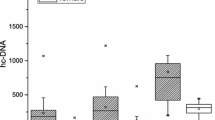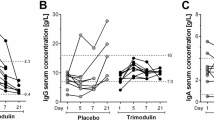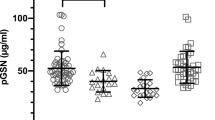Abstract
Recent evidence suggests complement (C) -stimulated granulocytes (PMNs) are important in a variety of diseases, including shock and myocardial infarction (MI). Corticosteroids inhibit PMN response to C and show promise in some studies of shock and MI, but their use has not become routine for several reasons. Synergy was sought among agents inhibiting PMN aggregation in vitro in response to activated C: methylprednisolone (MP), with a 50% inhibitory dose (AD50) of 0.6 mg/ml; ibuprofen (IBU), with AD50 of 1.0 mg/ml, and betahistine (BH), with AD50 of 1.6 mg/ml. Simultaneous use of all three agents produced 3.4-fold synergy; 3-fold synergy obtained between IBU + MP and IBU + BH, while 1.5-fold synergy was noted between MP + BH. Further, MP and IBU were at least additive in inhibiting · O −2 a generation by FMLP-stimulated PMNs and in blocking directed migration. In a preliminary in vivo test of this finding, cats were given MP and IBU—in known individually ineffective doses—immediately prior to coronary artery ligation. Neither MP nor the low dose of IBU chosen limited the size of the resultant MI, while both agents together reduced MI size by 42%. Synergy among these agents suggests that they inhibit PMN function of distinct cellular mechanisms (as yet not elucidated). Further, early in vivo results encourage speculation that such synergy might ultimately be exploited clinically, although such speculation must presently be regarded as preliminary.
Similar content being viewed by others
References
Jacob, H. S., P. R. Craddock, D. E. Hammerschmidt, andC. F. Moldow. 1980. Complement-induced granulocyte aggregation: An unsuspected mechanism of disease.N. Eng. J. Med. 302:789–794.
Redl, H., andG. Schlag. 1980. Morphologische Untersuchen der Lunge im Schock.In Anaesthesiologie und Intensivmedizin, Band 25, Kreislaufsschock. Springer-Verlag, Berlin.
Hosea, S., E. Brown, C. Hammer, andM. Frank. 1980. Role of complement activation in a model of adult respiratory distress syndrome.J. Clin. Invest. 66:375–382.
Hammerschmidt, D. E., L. J. Weaver, L. D. Hudson, P. R. Craddock, andH. S. Jacob. 1980. Association of complement activation and elevated plasma-C5a with adult respiratory distress syndrome: Pathophysiologic relevance and possible prognostic value.Lancet 1:947–949.
Thakur, M. L., A. Gottschalk, andB. L. Zaret. 1979. Imaging experimental myocardial infarction with indium-111-labeled autologous leukocytes: Effects of infarct age and residual regional myocardial blood flow.Circulation 60:297–305.
Hill, J. A., andP. A. Ward. 1971. The phlogistic role of C3 leukotactic fragments in myocardial infarcts of rats.J. Exp. Med. 133:885–900.
Lauter, C. B., M. R. El Khatib, J. A. Rising, andE. Robin. 1973. The nitrobluetetrazolium test in acute myocardial infarction.Ann. Intern. Med. 79:59–62.
Boyer, J. T., andR. A. O'Rourke. 1974. Consumption of classical complement by heart subcellular membranes in vitro and in patients after acute myocardial infarction.J. Clin. Invest. 56:740–750.
Hartmann, J., J. Robinson, andR. Gunnar. 1977. Chemotactic activity in the coronary sinus after experimental myocardial infarction: Effects of pharmacologie interventions on ischemic injury.Am. J. Cordial 40:550–555.
Hammerschmidt, D. E., J. G. White, P. R. Craddock, andH. S. Jacob. 1979. Corticosteroids inhibit complement-mediated granulocyte aggregation: A possible mechanism for their efficacy in shock states.J. Clin. Invest. 63:798–803.
White, G. L., L. T. Archer, B. K. Beller, andL. B. Hinshaw. 1978. Increased survival with methylprednisolone treatment in canine endotoxin shock.J. Surg. Res. 25:357–364.
Schumer, W. 1976. Steroids in the treatment of clinical septic shock.Ann. Surg. 184:333–341.
Sladen, A. 1976. Methylprednisolone. Pharmacologie doses in shock lung syndrome.J. Thorac. Cardiovasc. Surg. 21:800–805.
Joyce, L. D., J. M. Smith, H. G. Mauer, andR. C. Lillehei. 1979. Reduction of experimental myocardial infarct size by combined treatment with methylprednisolone sodium succinate and betahistine hydrochloride.Adv. Shock Res. 1:235–249.
Craddock, P. R., D. E. Hammerschmidt, J. G. White, A. P. Dalmasso, andH. S. Jacob. 1977. Complement (C5a)-induced granulocyte aggregation in vitro: A possible mechanism of complement-mediated leukostasis and leukopenia.J. Clin. Invest. 60:261–264.
Bøyum, A. 1968. Isolation of mononuclear cells and granulocytes from blood. Isolation of mononuclear cells by one centrifugation and of granulocytes by combining centrifugation and sedimentation at 1 g.Scand. J. Lab. Invest. 21(Suppl. 97):77–89.
Zigmond, S. H., andJ. G. Hirsch. 1973. Leukocyte locomotion and chemotaxis. New methods for evaluation and demonstration of cell-derived chemotactic factor.J. Exp. Med. 137:387.
Boyden, S. 1962. The chemotactic effect of mixtures of antibody and antigen on polymorphonuclear leukocytes.J. Exp. Med. 115:453.
Weening, R. S., R. Wever, andD. Roos. 1975. Quantitative aspects of the production of Superoxide radicals by phagocytizing human granulocytes.J. Lab. Clin. Med. 85:245–252.
Craddock, P. R., D. E. Hammerschmidt, C. F. Moldow, O. Yamada, andH. S. Jacob. 1979. Granulocyte aggregation as a manifestation of membrane interactions with complement: Possible role in leukocyte margination, microvascular occlusion and endothelial damage.Sem. Haematol. 16:140–147.
Darsee, J. R., R. A. Kloner, andE. Braunwald. 1981. Demonstration of lateral and epicardial border zone salvage by flurbiprofen using an in vivo method for assessing myocardium at risk.Circulation 63:29–35.
Hunt, D. P., andR. J. Leigh. 1980. Overdose of ibuprofen causing unconsciousness and hypotension.Brit. Med. J. 281:1458.
Boots Pharmaceutical Co. Brufen 400: Pharmakologie und Klinische Erfahrung. Braumapharm Ges.m.b.H., Vienna, 1981. 34–35.
Skubitz, K. M., P. R. Craddock, D. E. Hammerschmidt, andJ. T. August. 1981. Corticosteroids block binding of chemotactic peptide to its receptors on granulocytes and cause disaggregation of granulocyte aggregates in vitro.J. Clin. Invest. 68:13–20.
Author information
Authors and Affiliations
Additional information
Material presented in part to the plenary session of the 1981 annual meeting of the American Federation for Clinical Research, San Francisco, California.
Work supported in part by the following grants: N.I.H.(U.S.A.): AM-15730, CA-09243, HL-19725, HL-07062, HL-25043, HL-26218.
Rights and permissions
About this article
Cite this article
Hammerschmidt, D.E., Flynn, P.J., Coppo, P.A. et al. Synergy among agents inhibiting granulocyte aggregation. Inflammation 6, 169–176 (1982). https://doi.org/10.1007/BF00916241
Issue Date:
DOI: https://doi.org/10.1007/BF00916241




